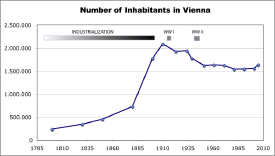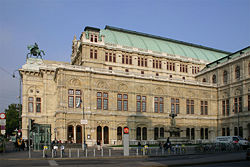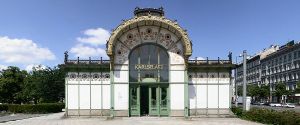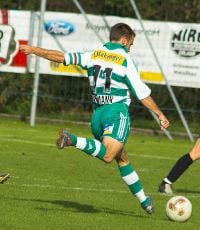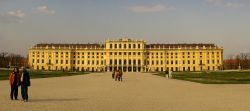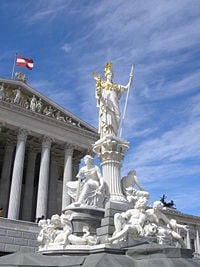| State Coat of Arms | |
|---|---|
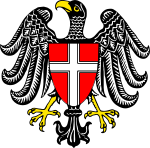
| |
| General Information | |
| Country: | Austria |
| State Capital: | Vienna |
| ISO 3166-2: | AT-9 |
| Vehicle Registration: | W |
| Postal codes: | 1010 - 1239, 1400, 1450 |
| Area code: | 01 |
| Homepage: | www.wien.gv.at |
| State Flag of Vienna | |
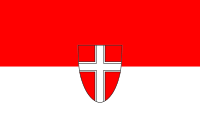
| |
| Map: Vienna in Austria | |
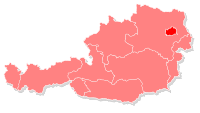
| |
| Name in other languages | |
| German | Wien |
| Politics | |
| Mayor and governor | Michael Ludwig (SPĂ) |
| Vice Mayor | Christoph Wiederkehr (NEOS) |
| Population | |
| Population: | 1,929,944 (2020)[1] 2,600,000 metro area |
| Population density: | 4,002.2/kmÂČ |
| Geography | |
| Area: | 414.90 kmÂČ |
| - percent land: | 395.51 kmÂČ (95,33%) |
| - percent water: | 19.39 kmÂČ (4,67%) |
| Location: | 48°13âČN 16°22âČE |
| Dimensions: | North-South: 22.4Â km East-West: 29.2Â km |
| Highest Point: | 543 m (Hermannskogel) |
| Lowest Point: | 151 m (Lobau) |
| Administrative Structure | |
| Districts: | 1 Statutarstadt 23 Bezirke |
| Map: Districts of Vienna | |
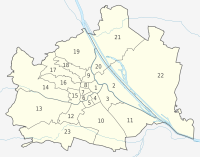
| |
Vienna (German: Wien, [ÊiËn], Austro-Bavarian: WeÄn,) is the capital of Austria, and also one of the nine States of Austria. Vienna is Austria's primate city; with a population of about 1.7 million (2.2 million within the metropolitan area), and is by far the largest city in Austria as well as its cultural, economic and political center. Vienna lies in the very east of Austria, close to the Czech Republic, Slovakia and Hungary. In 1683, the city became the residence of the Habsburg dynasty, and many aristocratic families built palaces and residences in the city. In 1805, Vienna became capital of the Austrian Empire, and later the Austro-Hungarian Empire, and played a major role in European and world politics. The map of Europe was redrawn at the 1815 Congress of Vienna. In 1918, after World War I, Vienna became capital of the First Austrian Republic. In 1938, German troops entered Austria and Hitler proclaimed the âAnschlussâ (joining) of Austria into the German Reich. 1945, Vienna again became the capital of Austria, initially divided into four zones by the Allies.
Today Vienna is a center of European culture, with more than one hundred art museums which, combined, attract more than eight million visitors annually. Vienna is also known as the home of many illustrious musicians, scientists and philosophers, including Ludwig van Beethoven, Martin Buber, Sigmund Freud, Gustav Klimt, Josef Lanner, Franz Schubert, Wolfgang Amadeus Mozart, Ludwig Wittgenstein, and Johann Strauss. In 2001, the city center was designated a UNESCO World Heritage Site.[2]
History
Founded around 500 B.C.E., Vienna was originally a Celtic settlement. The name â Wienâ derived from the Celtic "Vedunia" for âriver in the woods.â In 15 B.C.E., Vienna became a Roman frontier city ("Vindobona") guarding the Roman Empire against Germanic tribes to the north. Remnants of the Roman camp can still be seen at Hoher Markt and at underground station Stephansplatz.
During the Middle Ages, Vienna was home of the Babenberg Dynasty, and in 1440 became residence of the Habsburg dynasties; Vienna eventually grew to become the secret capital of the Holy Roman Empire and a cultural center for arts and science, music and fine cuisine. The Ottoman invasions of Europe in the sixteenth and seventeenth centuries were stopped twice just outside of Vienna (Siege of Vienna, 1529 and Battle of Vienna, 1683). After 1683, when the Turks were no longer a threat, Vienna became the official residence of the Hapsburg family and many aristocratic families built palaces and residences in the city. From 1740 until 1780, a program of modernization was undertaken by Empress Maria Theresia, joined in 1765 by her son Joseph II. In the late eighteenth century, Vienna became a center of culture and learning.
In 1805, Vienna became capital of the Austrian Empire, and later the Austro-Hungarian Empire, and played a major role in European and world politics. The map of Europe was redrawn at the 1815 Congress of Vienna. In 1857 the ramparts surrounding the city were dismantled, and replaced with the Ringstrasse (ring road). The Austro-Hungarian Empire came into existence in 1867.
In 1918, after World War I, Vienna became capital of the First Austrian Republic. Adolf Hitler lived in Vienna from 1907 until 1913. The Academy of Fine Arts of the city rejected him as a student, and when Hitler was broke and homeless, he stayed at homeless shelters like the one on the Meldemann Strasse. In 1934, after a coup dâĂ©tat by the âAustrofascists,â a clerical-fascist dictatorship is established under Dollfuss. In 1938, German troops entered Austria and Hitler spoke to the Austrian people from the balcony of the Neue Burg, a part of the Hofburg at the Heldenplatz, proclaiming the âAnschlussâ (joining) of Austria into the German Reich. Between the 1938 Anschluss and the end of the Second World War, Vienna lost its status as a capital to Berlin.
In 1945, the Vienna Offensive was successfully launched by the Soviets against the Germans holding Vienna. The city was besieged for about two weeks before it fell to the Soviets. After 1945, Vienna again became the capital of Austria. Initially divided into four zones by the Allies, Vienna became a hot-bed for international espionage between the Western and Eastern blocs.
Demographic history
Due to industrialization and immigration from other parts of the Empire, the population of Vienna increased sharply during its time as capital of Austria-Hungary (1867-1918). However, after World War I, many Czechs and Hungarians returned to their ancestral countries, resulting in a decline in the Viennese population. At the height of the immigration, about one third of the people living in Vienna were of Slavic or Hungarian descent.
By 2001, only 16 percent of people living in Vienna had nationalities other than Austrian, nearly half of which were from the former Yugoslavia.
Subdivisions
Vienna is composed of twenty-three districts (Bezirke). Legally, they are not districts in the sense of administrative bodies with explicit powers (such as the districts in the other Austrian states), but mere subdivisions of the city administration. Elections at the district level give the representatives of the districts some political power in fields such as planning and traffic.
The 23 districts are numbered for convenience in a roughly clockwise fashion starting in the city centre: 1. Innere Stadt, 2. Leopoldstadt, 3. LandstraĂe, 4. Wieden, 5. Margareten, 6. Mariahilf, 7. Neubau, 8. Josefstadt, 9. Alsergrund, 10. Favoriten, 11. Simmering, 12. Meidling, 13.Hietzing, 14. Penzing, 15. Rudolfsheim-FĂŒnfhaus, 16. Ottakring, 17. Hernals, 18. WĂ€hring, 19. Döbling, 20. Brigittenau, 21. Floridsdorf, 22. Donaustadt, 23. Liesing.
The heart and historical city of Vienna, the Innere Stadt, was once surrounded by walls and open fields in order to deny cover to potential attackers. The walls were razed in 1857, making it possible for the city to expand and eventually merge with the surrounding villages. In their place, a broad boulevard called the RingstraĂe was built, along which imposing public and private buildings, monuments, and parks now lie. These buildings include the Rathaus (town hall), the Burgtheater, the University, the Parliament, the twin museums of natural history and fine art, and the Staatsoper. It is also the location of the Hofburg, the former imperial palace. The mainly Gothic Stephansdom is located at the centre of the city, on Stephansplatz. Beyond the RingstraĂe, there was another wall called the Linienwall, which was torn down in the latter half of the nineteenth century to make room for expanding suburbs. It is now a ring road called GĂŒrtel.
Industries are located mostly in the southern and eastern districts. The Innere Stadt is situated away from the main flow of the Danube, but is bounded by the Donaukanal ("Danube canal"). Vienna's second and twentieth districts are located between the Donaukanal and the Danube River. Across the Danube are the newest districts, which include the location of the Vienna International Centre.
Vienna's postal codes can be determined by the district where a given address is located; 1XXA - 1 denotes Vienna, XX the district number (if it is a single digit then with a leading zero), A is the number of the post office (irrelevant in this case, usually zero). Example: 1070 for Neubau. Exceptions include 1300 for the Vienna International Airport located in Lower Austria near Schwechat, 1400 for the UN Complex, 1450 for the Austria Center, and 1500 for the Austrian UN forces.
Politics
Vienna is today considered the centre of Social Democracy in Austria. Until 1918, Viennese politics were shaped by the Austrian Christian Social Party. During the period of the First Republic (1918-1934), the Vienna Social Democrats undertook many overdue social reforms, improving the quality of life for hundreds of thousands of workers in the city. At that time, Vienna's municipal policy was admired by Socialists throughout Europe, who therefore referred to the city as "Red Vienna" (Rotes Wien). Since the end of the First World War, the city has been governed by the Social Democratic Party with absolute majorities in the city parliament. Between 1934 and 1945, when the Social Democratic Party was illegal, mayors were appointed by the austro-fascist and later by the Nazi authorities.
Ever since Vienna obtained federal state (Bundesland) status of its own in 1921, the mayor has also had the role of the state governor (Landeshauptmann). The Rathaus accommodates the offices of the mayor and the state government (Landesregierung). The city is administered by a multitude of departments (Magistratsabteilungen).
Culture
| Historic Centre of Vienna* | |
|---|---|
| UNESCO World Heritage Site | |
| State Party | |
| Type | Cultural |
| Criteria | ii, iv, vi |
| Reference | 1033 |
| Region** | Europe |
| Inscription history | |
| Inscription | 2001Â (25th Session) |
| * Name as inscribed on World Heritage List. ** Region as classified by UNESCO. | |
Religion
Vienna is the seat of the Viennese Roman Catholic archdiocese, in which is also vested the exempt Ordinariate for Byzantine-rite Catholics in Austria; its Archbishop is Cardinal Christoph Schönborn. Many Catholic churches in central Vienna feature performances of religious or other music, including masses sung to classical music and organ.
Some of Vienna's most significant historical buildings are Catholic churches, including the St. Stephen's Cathedral (Stephansdom), Karlskirche, Peterskirche, and the Votivkirche. On the banks of the Danube, there is a Buddhist Peace Pagoda, built in 1983 by the monks and nuns of Nipponzan Myohoji.
Music, theatre and opera
Art and culture, including theatre, opera, classical music and fine arts, have a long tradition in Vienna. The Burgtheater is considered one of the best theatres in the German-speaking world alongside its branch, the Akademietheater. The Volkstheater Wien and the Theater in der Josefstadt also enjoy good reputations. There is also a multitude of smaller theatres, in many cases devoted to less mainstream forms of performing arts, such as modern, experimental plays or cabaret.
Vienna is also home to a number of opera houses, including the Staatsoper (Vienna State Opera) and the Volksoper (Vienna Volksoper), the latter being devoted to the typical Viennese operetta. Classical concerts are performed at well known venues such as the Wiener Musikverein, home of the Vienna Philharmonic Orchestra, and the Wiener Konzerthaus. Many concert venues offer concerts aimed at tourists, featuring popular highlights of Viennese music (particularly the works of Wolfgang Amadeus Mozart and Johann Strauss).
In recent years, the Theater an der Wien has become widely known for hosting premieres of musicals, although it has recently devoted itself to the opera again. The most successful musical by far was "Elisabeth," which was later translated into several other languages and performed all over the world. The Haus der Musik ("house of music") opened in 2000.
Many Roman Catholic churches in central Vienna also feature performances of religious or other music, including masses sung with classical music and organ.
Viennese Waltz
The Viennese Waltz, oldest of all ballroom dances, emerged in the second half of the eighteenth century from the German dance and the LĂ€ndler in Austria. In the beginning it was disapproved of because the ladiesâ ankles were visible, and was considered unsuitable for unmarried girls. Later it gained official acceptance and became popular due to the Congress of Vienna at the beginning of the nineteenth century, and the famous compositions by Josef Lanner, Johann Strauss I and his son, Johann Strauss II.
The Viennese Waltz has always been a symbol of political and public sentiment. It was called the "Marseillaise of the heart" (by Eduard Hanslick, a critic from Vienna in the past century) and was supposed to "have saved Vienna the revolution" (in a biography of the composer Johann Strauss I). Heinrich Laube, a poet from the north of Germany, called Strauss I the "Napoleon Autrichien".
Museums
The Hofburg is the location of the Schatzkammer (treasury), holding the imperial jewels of the Hapsburg dynasty. The Sisi Museum (a museum devoted to Empress Elisabeth Amalie Eugenie of Austria) allows visitors to view the Imperial apartments as well as the silver cabinet. Directly opposite the Hofburg are the Kunsthistorisches Museum and the Naturhistorisches Museum, which house many paintings by old masters and ancient and classical artifacts.
A number of museums are located in the Museumsquartier (museum quarter), the former Imperial Stalls which were converted into a museum complex in the 1990s. It houses the Museum of Modern Art (Ludwig Foundation), the Leopold Museum (focusing on works of the Viennese Secession, Viennese Modernism and Austrian Expressionism), additional halls with feature exhibitions and the Tanzquartier. The Liechtenstein Palace contains one of the world's largest private art collections. There are a multitude of other museums in Vienna, including the Military History Museum, the Technical Museum, the Vienna Clock Museum and the Burial Museum. The museums dedicated to Vienna's districts provide a retrospective of the respective districts.
Architecture
A variety of architectural styles can be found in Vienna, such as the Romanesque Ruprechtskirche and the Baroque Karlskirche. Styles range from classicist buildings to modern architecture. Art Nouveau left many architectural traces in Vienna. The Secession, Karlsplatz Stadtbahn Station, and the Kirche am Steinhof by Otto Wagner rank among the best known examples of Art Nouveau in the world.
The Hundertwasserhaus by Friedensreich Hundertwasser, designed to counter the clinical look of modern architecture, is one of Vienna's most popular tourist attractions. Another example of unique architecture is the Wotrubakirche (Wotruba Church) by sculptor Fritz Wotruba.
In the 1990s, a number of quarters were adapted and extensive building projects were implemented in the areas around Donaustadt (north of the Danube) and Wienerberg (in southern Vienna). The 663 foot (202 m)-high Millennium Tower, located at Handelskai, is the highest building in Vienna. In recent years, Vienna has seen numerous architecture projects completed which combine modern architectural elements with old buildings, such as the remodelling and revitalization of the old Gasometer in 2001.
Most buildings in Vienna are relatively low; there are currently (early 2006) around 100 buildings higher than 40Â m. The number of high-rise buildings is kept low by building legislation aimed at preserving green areas and districts designated as world cultural heritage. Strong rules apply to the planning, authorization and construction of high-rise buildings. Consequently, much of the inner city is a high-rise free zone.
Education
Vienna is also Austria's main center of education and home to many universities, professional colleges and gymnasiums.
Universities
- Academy of Fine Arts Vienna
- Austrian Diplomatic Academy
- Medical University of Vienna
- PEF Private University of Management Vienna
- University of Applied Arts Vienna
- University of Natural Resources and Applied Life Sciences, Vienna
- University of Music and Performing Arts, Vienna
- University of Vienna
- University of Veterinary Medicine Vienna
- Vienna University of Economics and Business Administration
- Vienna University of Technology
- Webster University Vienna
- Internationales Kulturinstitut
International schools
- American International School Vienna
- Danube International School
- Vienna Christian School
- Vienna International School
- Lycée Francais de Vienne
Transportation
Twelve bridges cross the Danube in the city, which is divided by the Danube and its branch, the Neue Donau ("new Danube").
Public transportation

Vienna has a large public transportation network.
- Vienna S-Bahn
- Vienna U-Bahn
- Local Railways (Lokalbahn Wien-Baden)
- Wiener Linien (= Vienna Lines, municipal company operating U-Bahn, tram, and most bus routes)
Vienna has an extensive tram and bus network - the tram network being third largest in the world. In the most populated areas of Vienna, public transport runs so frequently (even during off-peak hours) that familiarity with departure timetables is virtually unnecessary. The convenience and flexibility of the public transport is in turn reflected by its popularity. During night hours, public transport is continued by the Nightline buses operating on all the main routes, generally every half hour.
Fare prices within the city are independent of the length of the journey and cover all modes of public transport. Daily, monthly and annual tickets are available. The Viennese public transport services are incorporated into a larger concentric system of transport zones, the VOR (Verkehrsverbund Ostregion = eastern region traffic association). VOR includes railway and bus lines operating 50 kilometers into the surrounding areas, and ticket prices are calculated according to the number of zones.
There are also two miniature railways: the Liliputbahn in the Wiener Prater and the Donauparkbahn in the Donaupark.
Railways
Historically, all transport was oriented towards the main cities in the Austro-Hungarian monarchy. Vienna has several train stations that form the beginning of train lines:
- Wien Franz-Josefs-Bahnhof, the starting point of the Franz Josef Railway
- Wien Westbahnhof, starting point of the Western Railway
- Wien SĂŒdbahnhof (Former South and East Station) for the Southern Railway and the Eastern Railway
There are also several through train stations:
- Wien HĂŒtteldorf on the Western Railway
- Wien Heiligenstadt on the Franz Josef Railway
- Wien Praterstern (Formerly known as Wien Nord or Wien Nord-Praterstern) on the Northern Railway.
- Wien Meidling (PhiladelphiabrĂŒcke) on the Southern Railway. This is Vienna's most frequented transit station.
- Wien Mitte (LandstraĂe) on the S-Bahn Stammstrecke ("main line") is the nearest railway station to the centre of Vienna.
A large number of smaller stations are important for local passenger traffic. Since the mid-1990s, the Westbahnhof and SĂŒdbahnhof have handled all long-distance travel. Many trains also stop at HĂŒtteldorf or Meidling, especially when inbound.
In order to bundle all long-distance traffic it has become necessary to build a tunnel, colloquially known as the Wildschweintunnel ("boar tunnel"), underneath Lainzer Tiergarten linking the Western Railway to the Southern Railway. The new bundled train line will connect to a new through train station called Wien Zentralbahnhof that will be constructed instead of the SĂŒdbahnhof.
Road traffic

Similar to the train lines, BundesstraĂen leave the city in a star-shaped pattern. Some are named after their historical final destination (Prager StraĂe to Prague, Linzer StraĂe to Linz, Triester StraĂe to Trieste and BrĂŒnner StraĂe to Brno). BundesstraĂen can be compared to Federal Highways in the United States, being two-lane in rural areas and multi-lane in urban areas.
Three national autobahns leave Vienna in the westerly (A1), southerly (A2), and easterly directions (A4). Similar to the rail lines, they are commonly referred to by their exit direction (Westautobahn, SĂŒdautobahn, and Ostautobahn). In addition, several spur and branch autobahns circle around the southern and eastern areas of the city. The protected Wienerwald forest area in the western and northern areas has been left mostly untouched.
Air traffic
Vienna International Airport is located to the southeast of Vienna. Following lengthy negotiations with surrounding communities, the airport will be expanded to increase its capacity by adding of a third runway. The airport is currently undergoing a major enlargement (construction of several new buildings) to prepare for an expected increase in passengers.
Water transportation
Vienna is connected to Rotterdam and German Industrial areas via the Rhine-Main-Danube Canal, and to Eastern European countries along the Danube to the Black Sea. The planned Danube-Oder canal remains unfinished. The "Twin City Liner" boat service connects Vienna and Bratislava.
Nearly all of Vienna's drinking water is brought to the city via two large water pipelines, built in the late nineteenth and early twentieth centuries. The pipelines stretch 120Â km (75Â miles) and 200Â km (124Â miles) from the Alps to the city's Hietzing district. The Alpine sources are pristine and the water does not require treatment.
Leisure activities
Viennese parks and gardens
Vienna possesses many park facilities and is one of the greenest cities in the world. Parks include the Stadtpark, the Burggarten, the Volksgarten (part of the Hofburg), the SchloĂpark at Schloss Belvedere (home to the Vienna Botanic Gardens), the Donaupark, the Schönbrunner Schlosspark, the Prater, the Augarten, the Rathauspark, the Lainzer Tiergarten, the Dehnepark, the Resselpark, the Votivpark, the Kurpark Oberlaa, the Auer-Welsbach-Park and the TĂŒrkenschanzpark. Green areas include Laaer-Berg (including the Bohemian Prater) and the foothills of the Wienerwald, which reaches into the outer areas of the city. Small parks, known by the Viennese as Beserlparks, are everywhere in the inner city areas.
Many of Vienna's famous parks include monuments, such as the Stadtpark with its statue of Johann Strauss II, and the gardens of the baroque palace, where the State Treaty was signed. Vienna's principal park is the Prater which is home to the Riesenrad, a ferris wheel. The imperial Schönbrunn's grounds contain an eighteenth century park which includes the world's oldest zoo (Tiergarten Schönbrunn), founded in 1752. The Donauinsel, part of Vienna's flood defenses, is a 21.1 km long artificial island between the Danube and Neue Donau dedicated to leisure activities.
Sport
Vienna hosts many different sporting events including the Vienna City Marathon, which attracts more than 10,000 participants every year and normally takes place in May. In 2005 the Ice Hockey World Championships took place in Austria and the final was played in Vienna. Vienna's Ernst Happel Stadium was the venue of four Champions League and European Champion Clubs' Cup finals (1964, 1987, 1990, 1995, and 2008).
Austria's capital is home to numerous teams. The best known are the local football clubs SK Rapid Wien (31 Austrian Bundesliga titles), FK Austria Wien (23 Austrian Bundesliga titles and 26-time cup winners) and the oldest team, First Vienna FC. Other important sport clubs include the Chrysler Vikings Vienna (American Football), who won the Eurobowl title in 2004, the Vienna Hot Volleys, one of Europe's premier Volleyball organizations, and the Vienna Capitals (Ice Hockey).
Culinary Specialities
Food
Vienna is well known for Wiener schnitzel, a cutlet of veal that is pounded flat, coated in flour, egg and breadcrumbs, and fried in clarified butter. It is available in almost every restaurant that serves Viennese cuisine. Other examples of Viennese cuisine include "Tafelspitz" (very lean boiled beef), which is traditionally served with "Gerösteten ErdÀpfeln" (boiled potatoes mashed with a fork and subsequently fried) and horseradish sauce, "Apfelkren" (a mixture of horseradish, cream and apple) and "Schnittlauchsauce" (a chives sauce made with mayonnaise and old bread).
Vienna has a long tradition of cakes and desserts. These include Apfelstrudel (hot apple strudel), Palatschinken (sweet pancakes), and Knödel (dumplings), often filled with fruit such as apricots (Marillenknödel). Sachertorte, a dry chocolate cake with apricot jam from the Sacher Hotel, is world famous.
In winter, small street stands sell traditional Maroni (hot chestnuts) and potato fritters. Sausages are also popular and available from street vendors throughout the night. The sausage known as Wiener (German for "Viennese") in the USA and Germany, is called a Frankfurter. Other popular sausages are Burenwurst (a coarse beef and pork sausage, generally boiled) and KĂ€sekrainer (spicy pork with small chunks of cheese).
The Naschmarkt is a permanent market for fruit, vegetables, spices, fish, meat and much more from around the world. The city centre has many specialty food stores, such as the "Julius Meinl am Graben."
Drink
Vienna is the world's only capital city with its own vineyards (although Paris also retains a single vineyard, and Prague has some also). The wine is served in small Viennese pubs known as Heuriger, which are especially numerous in the wine growing areas of Döbling (Grinzing, Neustift am Walde, NuĂdorf, Salmannsdorf, Sievering) and Floridsdorf (Stammersdorf, Strebersdorf). The wine is often drunk as a spritzer ("G'spritzter") with sparkling water. The GrĂŒner Veltliner, a white wine, is the most widely cultivated wine in Austria.
Beer is next in importance to wine. Vienna has a single large brewery, Ottakringer, and more than ten microbreweries. A "Beisl" is a typical small Austrian pub, of which Vienna has many.
Viennese cafés
Viennese cafés have an extremely long and distinguished history that dates back centuries, and the famous historical patrons of the oldest are something of a local legend, called "café society". Traditionally, the coffee comes with a glass of water. Viennese cafés claim to have invented the process of filtering coffee from bounty captured after the second Turkish siege in 1683. Viennese cafés claim that when the invading Turks left Vienna, they abandoned hundreds of sacks of coffee beans. The Emperor gave Franz George Kolschitzky some of this coffee as a reward for providing information that allowed the Austrians to defeat the Turks. Kolschitzky then opened Vienna's first coffee shop. Julius Meinl set up a modern roasting plant in the same premises where the coffee sacks were found, in 1891.
Tourist Attractions
Major tourist attractions include the imperial palaces of the Hofburg and Schönbrunn (also home to the world's oldest zoo, Tiergarten Schönbrunn) and the Riesenrad in the Prater. Cultural highlights include the Burgtheater, the Wiener Staatsoper, the Lipizzaner horses at the spanische Hofreitschule and the Vienna Boys' Choir, as well as excursions to Vienna's Heuriger districts.
More than 100 art museums together attract over eight million visitors per year. The most popular ones are Albertina, Belvedere, Leopold Museum in the Museumsquartier, KunstHausWien, BA-CA Kunstforum, the twin Kunsthistorisches Museum and Naturhistorisches Museum, and the Technisches Museum Wien.
There are many popular sites associated with composers who lived in Vienna, including Beethoven's various residences and grave at Zentralfriedhof (Central Cemetery) which is the largest cemetery in Vienna and the burial site of many famous people. Mozart has a memorial grave at the Hapsburg gardens and at St. Marx cemetery (where his grave was lost). Vienna's many churches also draw large crowds; the most famous are St. Stephen's Cathedral, the Deutschordenskirche, the Jesuitenkirche, the Karlskirche, the Peterskirche, Maria am Gestade, the Minoritenkirche, the Ruprechtskirche, the Schottenkirche and the Votivkirche.
Modern attractions include the Hundertwasserhaus, the United Nations headquarters and the view from the Donauturm.
International Organizations in Vienna

Vienna is the seat of a number of United Nations offices and various international institutions and companies, including the United Nations Industrial Development Organization (UNIDO), the Organization of Petroleum Exporting Countries (OPEC), the International Atomic Energy Agency (IAEA), the Preparatory Commission for the Comprehensive Nuclear-Test-Ban Treaty Organization (CTBTO) and the Organization for Security and Co-operation in Europe (OSCE). The 1980 Diplomatic Conference that led to the adoption of the United Nations Convention of Contracts for the International Sale of Goods was held in Vienna. Vienna is also the seat of the United Nations Commission on International Trade Law's secretariat (UNCITRAL).
Charitable Organizations in Vienna
Alongside the international and intergovernmental organizations, dozens of charitable organizations are based in Vienna, providing relief goods and assistance to tens of thousands of disadvantaged children and needy people in developing countries.
One such organization is the network of SOS Children's Villages, founded by Hermann Gmeiner in 1949. Today, SOS Children's Villages are active in 132 countries and territories worldwide. Others include HASCO and the Childrens Bridge of Hope.
Notable Residents
During the eighteenth century Vienna became a European cultural center and home to several important schools and universities. A remarkable number of talented musicians, artists, scientists and philosophers lived and worked there:
- Marie Antoinette, née 'Maria Antonia', daughter of Empress Maria Theresa of Austria, last Queen of France (1774-1792)
- Maria Theresia, daughter of Emperor Charles VI, Holy Roman Emperor, Queen of Bohemia and Hungary (1740-1780)
- Alfred Adler, founder of individual psychology
- Victor Adler, social democrat and activist for the rights of workers
- Wolfgang Ambros, one of the founders of Austropop
- Hans Asperger, pediatrician, discoverer of Asperger syndrome
- André Asriel, composer
- Carl Auer von Welsbach, chemist
- Ludwig van Beethoven
- Alban Berg, composer
- Ludwig Boltzmann, physicist
- Martin Buber, philosopher
- Peter Drucker, economist
- Albert Ehrenstein, writer
- Viktor Frankl, psychologist, neurologist, founder of Logotherapy
- Sigmund Freud, neurologist, founder of the psychoanalytic school of psychology
- Karl von Frisch, zoologist, animal psychologist, bee keeper, Nobel Prize Laureate
- Friedrich Gulda, pianist and composer
- Eduard Haas III, inventor of PEZ candy
- Friedrich Hayek, economist, Nobel Prize winner
- Andre Heller, poet, song writer, artist
- Theodor Herzl, journalist, founder of modern political Zionism
- Friedensreich Hundertwasser, artist, architect, painter
- Wolfgang Hutter - artist, painter, university art professor
- Franz König, Cardinal Archbishop
- Gustav Klimt, painter
- Karl Kraus, satirist, publisher of "Die Fackel"
- Wolfgang Kraus, essayist, leader for many years of the Ăsterreichische Gesellschaft fĂŒr Literatur
- Karl Landsteiner, doctor, bacteriaologist, discoverer of blood group, Nobel Prize Laureate
- Fritz Lang, director
- Josef Lanner, composer
- Henry Lehrman, silent film director
- Leopold Lindtberg, director
- Konrad Lorenz, behavioural scientist, Nobel Prize Laureate
- Friederike Mayröcker, writer
- Lise Meitner, physicist
- Wolfgang Amadeus Mozart
- Johann Nestroy, playwright
- Wolfgang Pauli, physicist
- Karl Popper, philosopher
- Arnold Schönberg, composer, music theorist, painter
- Erwin Schrödinger, physicist, Nobel Prize Laureate
- Franz Schubert, composer
- Johann Strauss I, composer
- Johann Strauss II, composer
- Otto Wagner, architect
- Anton von Webern, composer
- Ludwig Wittgenstein, philosopher
- Joe Zawinul, jazz pianist, keyboard player, and composer
- Stefan Zweig, writer
Twin cities
Vienna is twinned with the following cities:
Other forms of cooperation and city friendship similar to the twin city programmes:
|
In addition, individual Viennese districts are twinned with Japanese cities/districts:
- Alsergrund with Takarazuka, Hyogo. Since 1994.
- Döbling with Setagaya, Tokyo. Since 1985.
- Donaustadt with Arakawa, Tokyo. Since 1996.
- Floridsdorf with Katsushika, Tokyo. Since 1987
- Hernals with Fuchu, Tokyo. Since 1992.
- Hietzing with Habikino, Osaka. Since 1995.
- Innere Stadt with Taito, Tokyo. Since 1989.
- Meidling with Gifu, Gifu. Since 1992.
Notes
- â Vienna Population 2020 World Population Review. Retrieved December 7, 2020.
- â Historic Centre of Vienna. UNESCO. Retrieved December 9, 2020.
ReferencesISBN links support NWE through referral fees
- Albrecht-Carrié, René. A diplomatic history of Europe since the Congress of Vienna. Harper's historical series. New York: Harper, 1958.
- Berkley, George E. Vienna and its Jews: the tragedy of success: 1880s-1980s. Cambridge, MA: Abt Books, 1988. ISBN 0819168165
- BrandstÀtter, Christian. Vienna 1900: Art, life & culture. New York: Vendome Press, 2006. ISBN 0865651752
- Brook, Stephen. Vienna. Eyewitness travel guides. London: Dorling Kindersley, 1994. ISBN 1564586472
- Dorling Kindersley Limited, and John Plumer. Vienna pocket guide. London: DK Pub., 2007. ISBN 9780756626594
- Johnston, William M. Vienna, Vienna: the golden age, 1815-1914. New York: C.N. Potter, 1981. ISBN 0517545551
- Regal, Wolfgang, and Michael Nanut. Vienna: A doctor's guide: 15 walking tours through Vienna's medical history. Wien: Springer, 2007. ISBN 9783211489499
External links
All links retrieved May 3, 2023.
- Wien.info Official site of the tourism board.
- Wien.gv.at Official site of the municipality.
- PhotoGlobe Vienna Geo-referenced photos of Vienna together with small maps and satellite images.
Credits
New World Encyclopedia writers and editors rewrote and completed the Wikipedia article in accordance with New World Encyclopedia standards. This article abides by terms of the Creative Commons CC-by-sa 3.0 License (CC-by-sa), which may be used and disseminated with proper attribution. Credit is due under the terms of this license that can reference both the New World Encyclopedia contributors and the selfless volunteer contributors of the Wikimedia Foundation. To cite this article click here for a list of acceptable citing formats.The history of earlier contributions by wikipedians is accessible to researchers here:
The history of this article since it was imported to New World Encyclopedia:
Note: Some restrictions may apply to use of individual images which are separately licensed.

